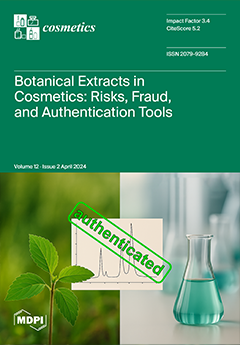Particulate matter (PM) is a significant pollutant that induces oxidative stress, inflammation, and structural skin damage, contributing to premature aging and reduced skin integrity. In this study, PM was applied topically to human ex vivo skin tissues to simulate real-world exposure, while test
[...] Read more.
Particulate matter (PM) is a significant pollutant that induces oxidative stress, inflammation, and structural skin damage, contributing to premature aging and reduced skin integrity. In this study, PM was applied topically to human ex vivo skin tissues to simulate real-world exposure, while test compounds were delivered using the culture medium to mimic systemic absorption or applied topically for direct surface treatment. Culture medium-based treatments included indomethacin, L-ascorbic acid, and rapamycin, whereas topical treatment involved retinol and epigallocatechin gallate (EGCG). PM exposure increased hydrogen peroxide (H
2O
2), interleukin 6 (IL-6), matrix metalloproteinase 1 (MMP-1), cyclooxygenase-2 (COX-2), and prostaglandin E
2 (PGE-2), while decreasing collagen type I and hyaluronic acid (HYA). Culture medium-based treatments improved collagen and reduced MMP-1 and COX-2 expression, with L-ascorbic acid and rapamycin lowering PGE-2, and indomethacin and rapamycin restoring HYA. L-ascorbic acid uniquely reduced IL-6. Topical treatments, including retinol and EGCG, effectively reduced H
2O
2 and MMP-1 and restored collagen type I. While both agents exhibited antioxidant activity, retinol further reduced IL-6, emphasizing its anti-inflammatory role. These results highlight the complementary protective effects of systemic-like and topical treatments in mitigating PM-induced skin damage. Future research should optimize protocols and validate efficacy under real-world conditions to enhance skin protection in polluted environments.
Full article





